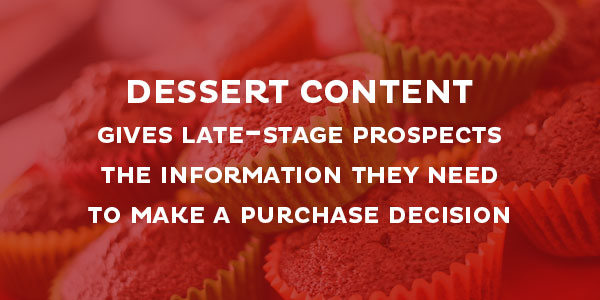Content masters create campaigns the same way master chefs create multi-course meals.
They think of each course as part of a journey through distinctive but thematically unified experiences. (Now re-read that in Anthony Bourdain’s voice. Much cooler, right? Feel free to have him narrate the rest of this post.)
We can look at a content campaign as a three-course meal:
- Appetizer (Early Stage): Appetizer pieces are typically fun and light, geared toward increasing brand awareness among a set of new prospects. These might include press releases, trade show collateral, infographics, and keyword-driven blog posts. You might even think of them as traditional Spanish tapas—the restaurant gives them away for free, knowing they’ll draw in a few more entree orders.
- Entree (Mid-Stage): The most basic purpose of entree pieces is to continue funneling the customer toward a purchase or sign up. To accomplish this, content teams often “gate” their entree pieces, requiring prospects to fill out a form in order to download the content. Entrees have to be meatier than appetizers in order to entice prospects to enter their information. Ebooks and research studies are popular entrees, since they can offer high-value content for the customer and can be highly targeted to drive qualified leads.
- Dessert (Late Stage): Dessert content gives late-stage prospects the final information they need to make a decision on your product or service. This might include product data sheets, templates your sales team can use to provide answers to specific questions, demo videos that show deeper-level product features, in-depth brochures, and finally case studies and lists of clients who have agreed to serve as references.

Just as the most serious diners are likely to stick around for the full three course meal, the most serious customers are likely to stick around for the full content asset experience.
Dessert assets are served to a smaller, more targeted audience typically based on that audience’s interaction with the larger campaign.
Once a prospect becomes a customer, they get access to a whole new menu of content, usually served in the form of drip campaigns that educate them on getting the most out of your product/service, webinars, special customer events, and newsletters that keep them up to date on industry trends and product/service updates.
Of course, the success of any lead generation and nurturing campaign is going to require a functional relationship between your marketing and sales teams (and we all know how tricky that can be). The good news is that sales and marketing alignment isn’t a mythical creature—it’s just a rare bird. Proof? Take a look at this real-life example from the team at Kapost.
